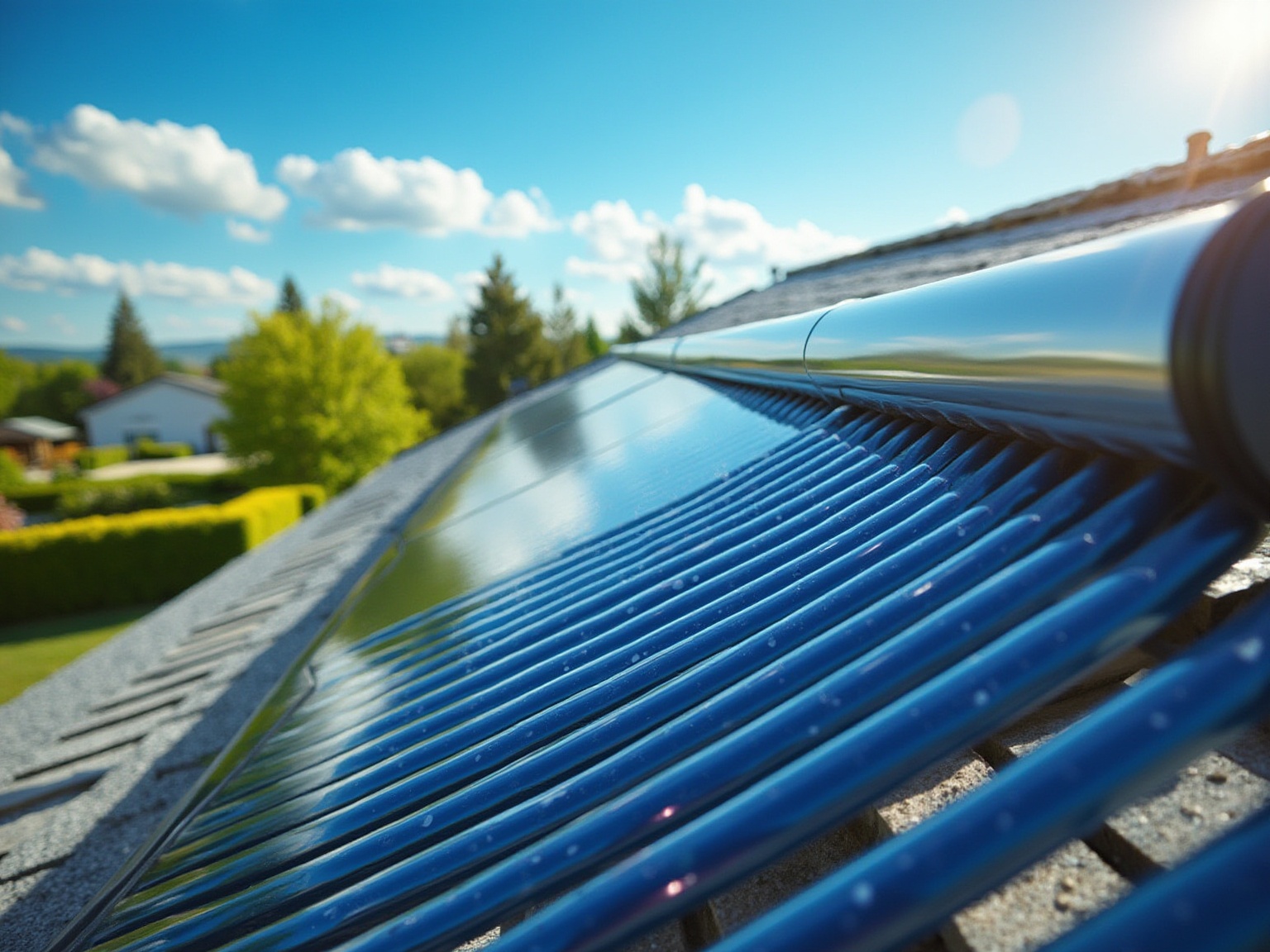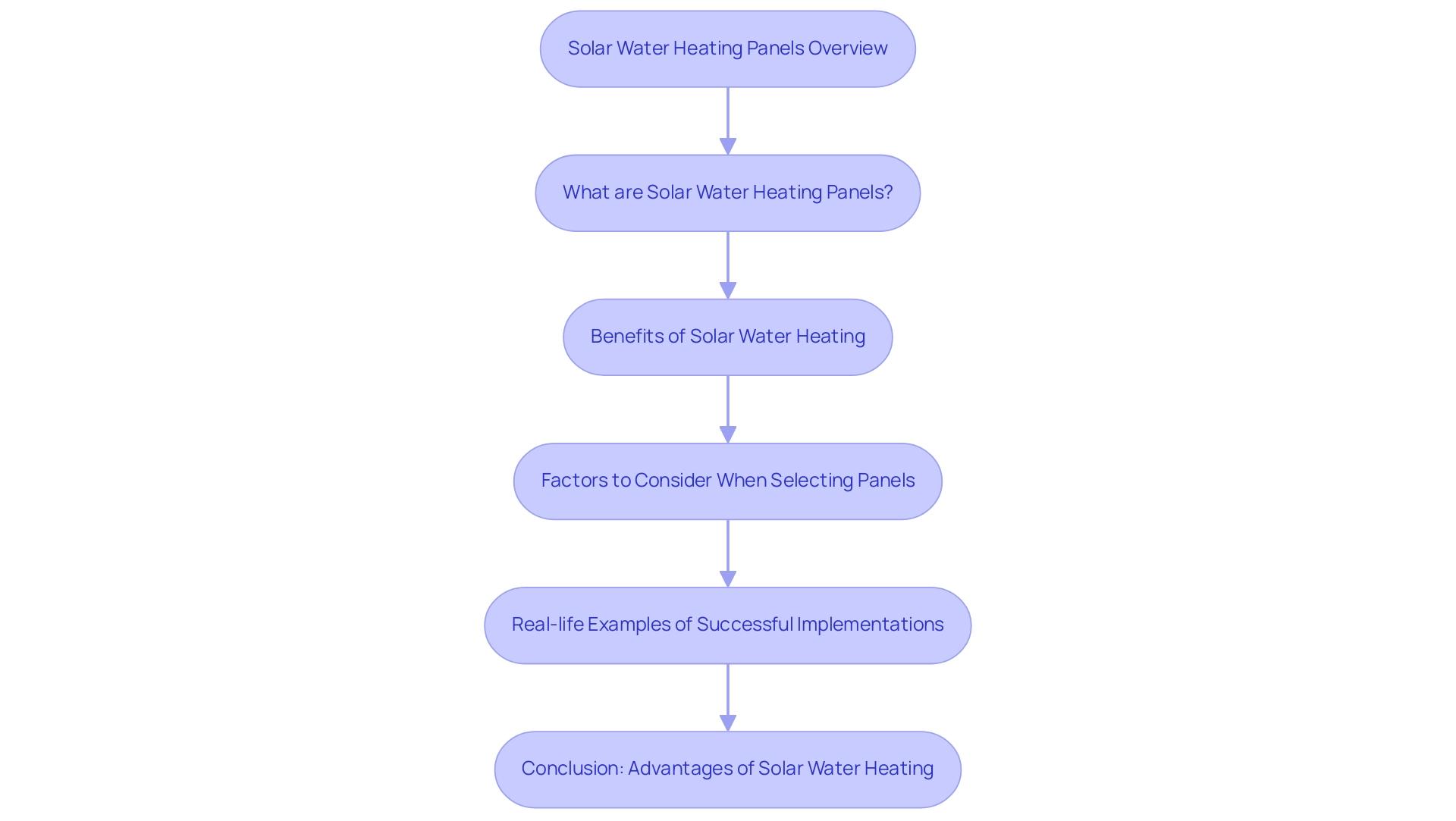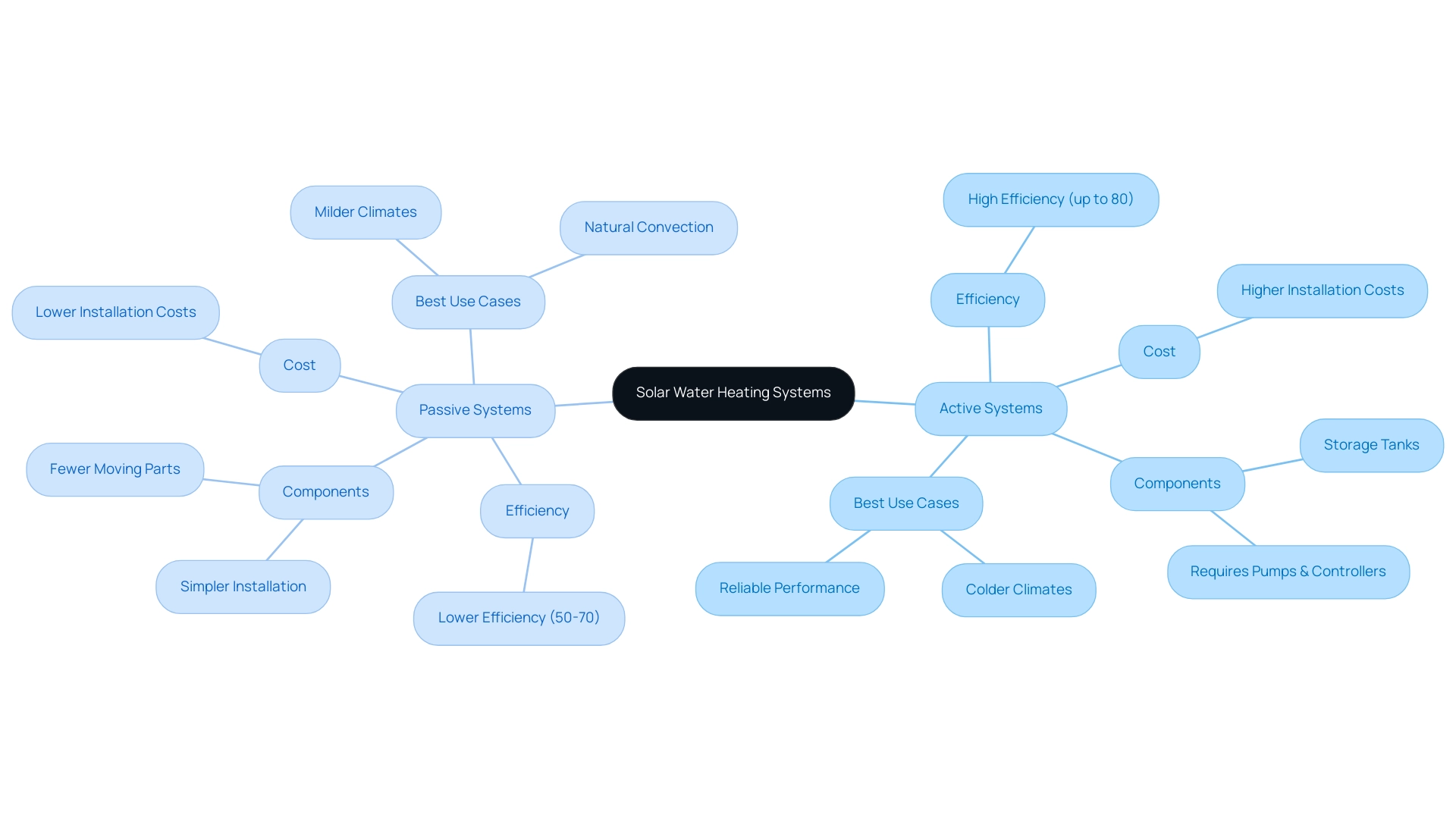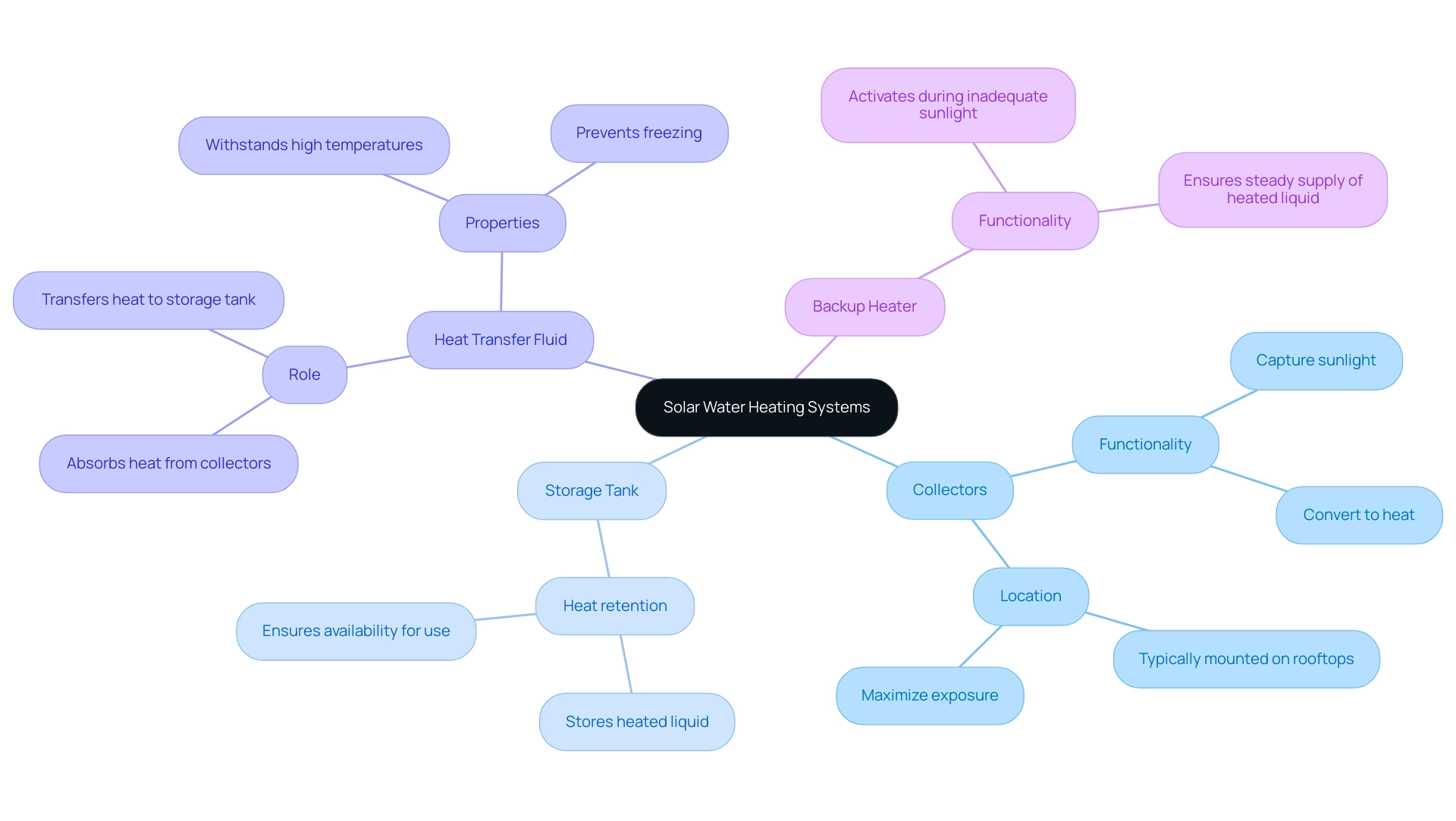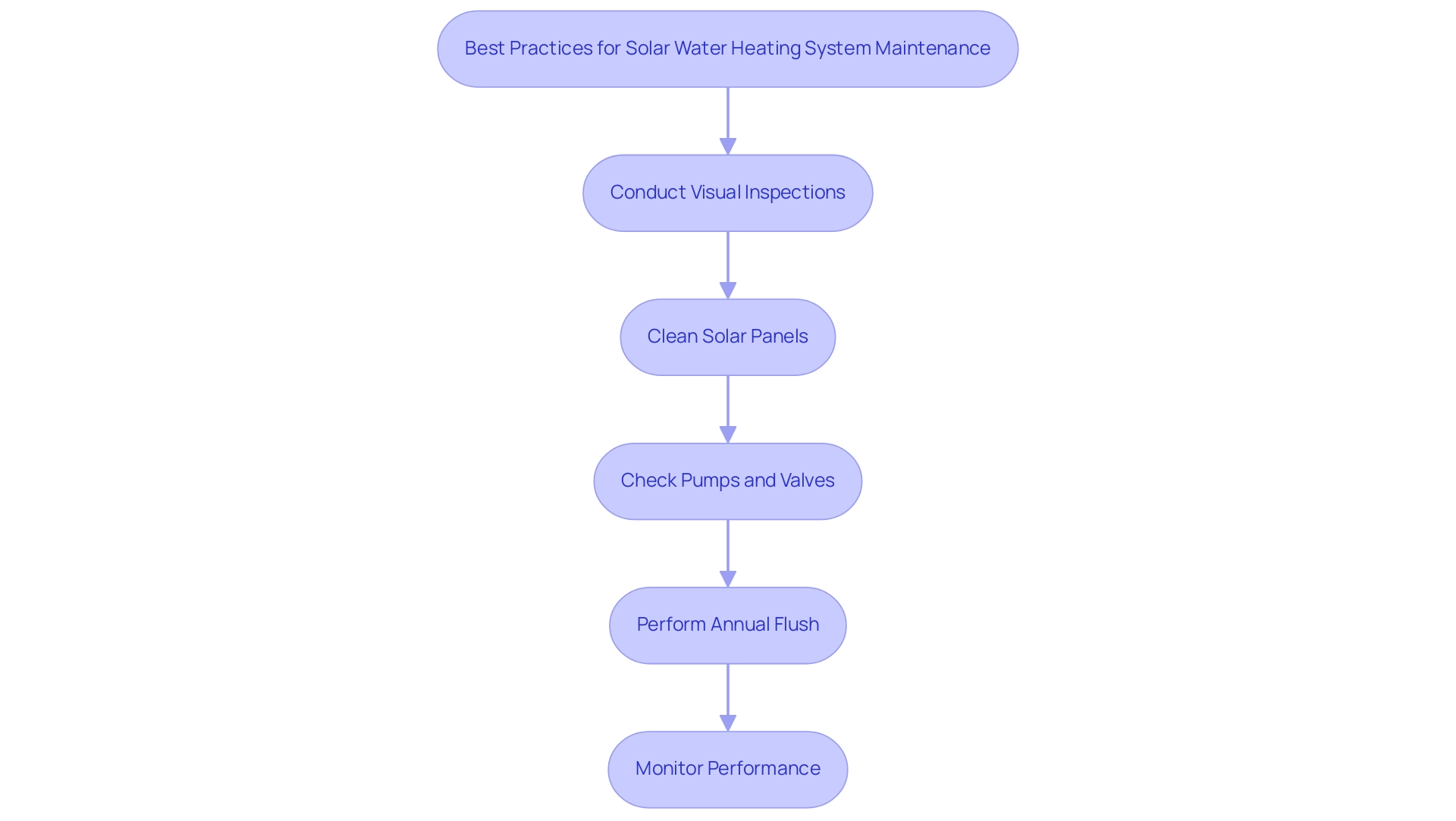Overview
Are you feeling overwhelmed by rising energy bills? Solar water heating panels offer a compassionate solution for homeowners like you, aiming to reduce costs while embracing sustainability. By harnessing the sun’s energy to heat water, these systems not only lead to significant savings on utility bills but also contribute to a healthier planet through reduced carbon emissions. Many users have shared their positive experiences, highlighting how these systems have transformed their energy habits and provided a sense of independence.
In regions like California, the adoption of solar water heating is growing rapidly, driven by increasing efficiency and attractive financial incentives for installation. We understand that making the switch can feel daunting, but the benefits are clear—both for your wallet and the environment. Together, we can explore how these systems can fit into your lifestyle and help you achieve your energy goals.
Imagine the peace of mind that comes from knowing you’re making a positive impact while enjoying lower energy bills. If you have questions or need guidance, we’re here to support you every step of the way. Let’s work towards a more sustainable future together—contact us today to learn more about how solar water heating can benefit you.
Introduction
In an age where energy efficiency and sustainability are paramount, we understand that many homeowners are concerned about rising utility bills. Solar water heating panels have emerged as a compelling solution for those seeking to embrace renewable energy while alleviating these financial pressures.
These innovative systems are designed to capture and convert sunlight into heat, providing not only significant savings but also contributing to a greener planet. With advancements in technology enhancing their efficiency, it’s common to feel hopeful about the possibilities.
Real-world success stories showcase the many benefits of solar energy, making it essential to understand the intricacies of solar water heating systems.
This article delves into the various aspects of solar water heating, exploring the types of systems available, cost considerations, maintenance best practices, and the environmental impact. Together, we can empower you to make informed decisions about your energy future.
What Are Solar Water Heating Panels?
Are you feeling overwhelmed by rising energy bills? Solar water heating panels, often referred to as thermal collectors, might just be the solution you’ve been searching for. These innovative devices are designed to capture sunlight and heat liquid in your home, offering a sustainable way to meet your energy needs. Typically, these systems consist of either flat plate collectors or evacuated tubes that efficiently transform sunlight into heat. The heated liquid produced can serve various purposes, from providing hot water for your home to warming swimming pools, enhancing your comfort and lifestyle.
The advantages of thermal panels are truly remarkable. By embracing solar water heating, homeowners can experience significant reductions in utility expenses, harnessing renewable sunlight and decreasing reliance on traditional energy sources. In fact, recent statistics reveal a notable increase in the adoption of solar water heating panels in California, with thousands of new installations each year. This trend reflects a growing commitment to sustainable energy solutions.
For example, consider the Aquamarine facility in Lemoore, which boasts a capacity of 325 MW, enough to power over 90,114 homes. This showcases the immense potential of solar energy in our state.
When selecting the best solar water heating panels for your home, it’s essential to consider factors such as your regional climate, household hot water needs, and budget. Additionally, ease of installation and maintenance should be a priority; look for options that offer comprehensive warranties and reliable manufacturer support. Don’t forget to pay attention to the First Hour Rating (FHR), a crucial performance metric that indicates how much heated fluid a heater can supply in the first hour of use. A higher FHR can be particularly beneficial for homes with greater hot water demands.
Experts agree on the advantages of thermal collectors. Mark Jacobson, a professor of Civil and Environmental Engineering, notes that fossil fuel consumption is expected to decline steadily until 2025, underscoring the importance of transitioning to renewable energy technologies like solar.
Recent advancements in thermal technology have further enhanced the efficiency of these systems. Innovations in materials and design have resulted in better heat retention and quicker heating times, making solar water heating an even more attractive option for homeowners.
Real-life experiences highlight the successful integration of solar water heating panels. Many California households have reported considerable savings and increased comfort after incorporating these systems. Case studies indicate that homeowners who installed solar water heating panels not only benefited from lower utility bills but also enjoyed the peace of mind that comes with energy independence.
Take Powercore Electric, for instance. They distinguish themselves through a strong community focus and personalized service, positioning themselves as a trustworthy choice for renewable energy solutions.
In conclusion, solar water heating panels offer a compassionate approach for homeowners eager to embrace sustainable practices while reaping the rewards of reduced utility costs and enhanced home comfort. Moreover, the latest advancements in NEM/NBT data released in September 2024 highlight the ongoing evolution of solar energy policies, reinforcing the case for solar heating solutions. Together, we can work towards a more sustainable future.
Types of Solar Water Heating Systems: Active vs. Passive
Are you feeling the pinch of rising energy bills? Solar heating installations offer a promising solution, classified into two main types: active and passive systems. Active setups, which use pumps and controls to circulate water or heat transfer fluids, significantly enhance efficiency, especially in colder climates. These systems include essential components like pumps, controllers, and storage tanks, ensuring better temperature regulation and effective energy capture.
On the other hand, passive setups rely on natural convection and gravity, making them simpler and often more cost-effective to install. While they are known for their reliability due to fewer moving parts, their performance can dip in colder regions where freezing temperatures pose challenges.
In California, the market for solar heaters is evolving, with active setups gaining popularity due to their superior efficiency. Recent evaluations indicate that these systems are poised to capture a significant share of the market, driven by their ability to deliver reliable performance even in less favorable weather conditions. For instance, a household in Southern California reported an impressive reduction of over 70% in their utility costs after installing a heating apparatus paired with a heat exchanger.
This setup not only resulted in substantial savings but also supported their sustainability goals by lowering their carbon footprint. In contrast, while passive approaches remain beneficial, homeowners are increasingly leaning towards options that promise enhanced efficiency.
Did you know that active solar water heating panels can achieve efficiency rates of up to 80% under optimal conditions? This is in stark contrast to passive alternatives, which typically range between 50% to 70%. This efficiency gap becomes even more pronounced in colder regions, where active systems maintain higher output levels, making them a more suitable choice for homeowners concerned about power reliability. For example, in cooler areas, passive designs have shown remarkable efficiency, with one notable case involving a home that utilized large south-facing windows to capture and retain sunlight during winter, significantly reducing utility costs.
Real-life examples highlight the effectiveness of active thermal heating setups, showcasing installations that have successfully lowered energy expenses and enhanced sustainability. With the thermal heater market projected to grow from $5.03 billion in 2025 to $6.61 billion by 2034, at a compound annual growth rate (CAGR) of 7.0%, the demand for efficient systems is on the rise. Homeowners may also find financial incentives appealing, such as the $750 rebate offered by Hawaii Energy for those who install solar water heating panels, which can greatly alleviate installation costs.
Christian Yonkers, a writer and outdoor enthusiast, emphasizes the importance of sustainable power solutions, stating, “The intersectionality between people and planet is crucial for our future.” This perspective underscores the growing awareness and necessity for efficient energy solutions.
Additionally, insights from market evaluation reports shed light on the heating systems market, including regional shares and key participants, enriching our understanding of this important topic. In conclusion, while both active and passive thermal heating setups present their unique advantages, the choice between them should consider factors such as climate, installation costs, potential utility bill savings, and available financial incentives. As homeowners in California explore these options, understanding the distinctions and efficiencies of each setup will be vital in making informed decisions about their energy needs.
Cost Analysis and Financial Incentives for Solar Water Heating
We understand that managing energy bills can be a significant concern for homeowners. The expense of setting up solar water heating panels typically ranges from $3,800 to $6,500, influenced by factors such as the type of panels chosen and the complexity of the installation process. However, many homeowners find comfort in the significant savings on their energy bills, with reductions in heating costs spanning from 50% to 80%. Furthermore, in 2025, several financial incentives are available to enhance the affordability of these sustainable solutions.
Notably, a federal tax credit of 30% is available for solar water heating panels installed through 2032, which can greatly reduce the upfront investment. Additionally, California homeowners may benefit from local rebates and incentives that vary by region, designed specifically to promote the adoption of renewable energy solutions. With 490 energy installers available in Winchester CDP, you have access to a wealth of local expertise that can guide you in making informed decisions.
At Powercore Electric, we pride ourselves on being a locally-owned company that understands the unique electrical needs of California communities. We ensure tailored solutions that cater to your specific location. For instance, Jeni R., a verified customer, shared, “Powercore Electric saved me a ton of money by helping me get bids that were half the cost of the bids I got myself by calling around.” This underscores the financial advantages of consulting with local experts who provide personalized service and timely communication.
To optimize your savings and fully understand the potential expenses associated with heating installations, we encourage you to seek advice from qualified contractors and manufacturers. Powercore Electric is here to help you navigate these options and provide a free, personalized estimate based on your specific needs. This approach not only guarantees precise budgeting but also enhances the financial benefits linked to heating installations. Together, we can work towards a more sustainable and cost-effective future for your home.
How Solar Water Heating Systems Work: Key Components and Functionality
Thermal heating arrangements consist of various crucial elements that work together to capture sunlight efficiently. These include:
- Collectors
- A storage tank
- Heat transfer fluid
- A backup heater
Solar Collectors: These devices capture sunlight and convert it into heat, typically mounted on rooftops to maximize exposure throughout the day.
- Storage Tank: After the heat collectors produce warmth, the heat transfer fluid moves through the setup, conveying this heat to the liquid held in the tank. This ensures that hot liquid is readily available for household use.
Heat Transfer Fluid: This liquid plays an essential role by absorbing heat from the collectors and transferring it to the liquid in the storage tank. It is designed to withstand high temperatures and prevent freezing in colder climates.
- Backup Heater: In situations where sunlight is inadequate—such as on overcast days or during peak usage times—the backup heater activates to ensure a steady supply of heated liquid.
We understand that navigating energy bills can be overwhelming for homeowners. Comprehending these elements is essential for those seeking to enhance their heating solutions. Current trends indicate a growing focus on efficiency, with the thermal heating market expected to develop considerably by 2025. Innovations like predictive analytics are improving performance and customer satisfaction, ensuring that homeowners can depend on their solutions for reliable savings.
Based on a recent report, the anticipated funding in photovoltaic technology is predicted to reach £162.1 billion by 2033, highlighting the growing significance of these technologies.
As the need for sustainable solutions rises, homeowners can benefit from incorporating water heating technologies into their power strategies. By understanding how these networks operate, they can make informed choices that contribute to energy independence and sustainability. As IRENA states, to stay on a pathway limiting global warming to 1.5°C, annual renewable power capacity additions must grow three times the current level by 2030. This emphasizes the urgency for homeowners to adopt renewable energy solutions.
Furthermore, Powercore Electric offers advanced, affordable energy solutions designed to maximize savings. With an in-house team of experts, we guarantee high-quality installations and maintenance. Our best pricing guarantee ensures you receive the best value for your investment.
This dedication to quality and service makes Powercore Electric a reliable option for homeowners in [City/Area] contemplating solar heating solutions, ensuring they obtain dependable and efficient power alternatives. Ready to save on your utility bills? Get your free, personalized estimate now!
Pros and Cons of Solar Water Heating: Is It Right for You?
Are you feeling overwhelmed by rising energy bills? Solar water heating panels might be the solution you’re looking for. These innovative systems offer numerous benefits, making them an appealing choice for homeowners who want to improve their energy efficiency and save money. One of the most significant advantages is the potential for substantial power savings. By harnessing the sun’s energy, solar water heating panels can significantly lower your electricity costs, especially in regions blessed with abundant sunshine and high electricity rates.
In fact, research shows that homeowners who install solar water heating panels report savings of up to 50% on their heating expenses after installation. Imagine what you could do with that extra money! Furthermore, installing a heat collector can enhance the value of your home, providing lasting economic benefits that go beyond just savings.
These systems are designed to deliver heated liquid throughout the year, even on overcast days, thanks to their ability to collect and retain energy from the sun. Maintenance requirements are minimal, which adds to their appeal for busy homeowners like you. Many property owners highlight long-term savings and environmental advantages as key factors in their positive experiences with these heating systems.
Consider the story of a household in Southern California that experienced a remarkable reduction in their utility costs—over 70%—after installing a heating apparatus combined with a heat exchanger. This setup not only provided significant savings but also supported their sustainability efforts by reducing their carbon footprint.
However, it’s important to consider potential drawbacks as well. The initial installation costs can be significant, which may deter some homeowners from making the switch. As Jamie Smith, a content writer and researcher at SolarReviews, wisely points out, “If you reside in a state that does not prioritize the adoption of renewable energy, there’s a chance you end up paying more for your installation and earn lower savings.”
Additionally, thermal heaters rely on sunlight, meaning their effectiveness can be influenced by weather conditions. Adequate roof space is also necessary for installation, which may not be feasible for every home. The case study titled ‘Pros and Cons of Solar Water Heating Panels’ illustrates that while these panels offer a sustainable solution for reducing electricity expenses, they do come with challenges, particularly regarding their dependence on sunlight and installation costs.
Practical examples further demonstrate the efficiency of heating systems utilizing sunlight. For instance, in cooler regions, passive power collection designs have proven to be very effective. One notable case involved a home that utilized large south-facing windows to capture and retain sunlight during the winter months, significantly reducing costs. However, it’s essential for individuals to assess their specific situations, including local climate and energy needs, to determine if thermal heating is the right choice for them.
Looking ahead to 2025, expert opinions continue to emphasize the importance of weighing both the advantages and disadvantages of water heating systems. While they provide a sustainable solution for lowering expenses, the challenges related to installation and dependence on sunlight should not be overlooked. As the market evolves, staying informed about advancements and trends in renewable technology will empower you to make informed decisions about your energy solutions.
Moreover, with the anticipated fivefold increase in photovoltaic generation in the UK by 2030, the significance of technological advancements in this field is becoming increasingly important.
To explore how solar heating solutions can benefit your home, we invite you to contact Powercore Electric today. Together, we can help you start saving on your utility bills while contributing to a sustainable future.
Maintaining Your Solar Water Heating System: Best Practices
To ensure the optimal performance and longevity of your water heating system, we understand that implementing a routine maintenance schedule is essential. Begin by conducting regular visual inspections to identify any signs of damage, leaks, or corrosion. Cleaning the solar water heating panels is crucial; aim to do this every few months to remove dirt and debris that can obstruct sunlight and reduce efficiency.
Neglecting this maintenance can lead to a significant drop in energy production, often due to dust and debris buildup. We want to help you avoid these pitfalls.
Additionally, check the functionality of key components such as pumps and valves to ensure they are operating correctly. An annual flush is recommended to eliminate sediment buildup, which can hinder performance and efficiency. Statistics suggest that properly maintained heating devices can attain a lifespan of 20 years or longer, considerably increasing their worth.
With 1.1 GW of residential renewable energy installed in Q3 2024, the importance of maintaining these setups is emphasized by the increasing acceptance of clean energy technology. The segment for solar water heating panels in residential areas is anticipated to expand at a CAGR of over 5% until 2034, underscoring the rising demand for these units and the essential role of upkeep.
Common issues include reduced heat transfer due to dirty collectors and malfunctioning pumps, both of which can be mitigated through proactive maintenance. Homeowners who follow these best practices not only benefit from a reliable hot supply but also enhance their savings. Technicians stress that “regular maintenance is the key to preventing expensive repairs and ensuring your equipment operates smoothly.”
Moreover, for homeowners with pools, incorporating resource-saving strategies and effective heating systems can improve comfort while lowering utility expenses. By adhering to these guidelines, you can keep your heating apparatus functioning effectively, ensuring it operates efficiently for many years ahead. As Anna Brui, a dedicated supporter of renewable resources, observes, “Sustainability begins at home, and caring for your solar water heating panels is a crucial part of that journey powered by the sun.
The Environmental Benefits of Solar Water Heating
We understand that rising energy bills can be a significant concern for homeowners. Solar heating installations offer considerable ecological benefits by greatly decreasing reliance on fossil fuels and limiting greenhouse gas emissions. By efficiently utilizing sunlight, these setups can reduce the total carbon footprint linked to heating liquids. Studies show that homes using renewable heating can prevent around 0.53 tons of CO2 emissions each year, resulting in significant decreases in greenhouse gas emissions throughout the lifespan of the installation, which can last up to 25 years.
It’s common to feel uncertain about the financial implications of such investments. However, the internal rate of return (IRR) for thermal heating installations, even without subsidies, ranges from 14% to 17.5%, showcasing their financial viability alongside their environmental advantages. This dual advantage makes them an attractive option for homeowners looking to save on energy costs while contributing to a sustainable energy future.
Moreover, the ecological effect of water heating installations reaches beyond single residences. By encouraging the utilization of renewable resources, these solutions play a crucial role in fostering a cleaner environment. Experts highlight that shifting to renewable sources not only reduces climate change but also improves power autonomy for homeowners.
Consider the case study titled ‘Environmental Impact of Solar Water Heating Panels.’ It highlights that the implementation of solar water heating panels can significantly reduce greenhouse gas emissions compared to traditional electric boilers. For example, a household in Southern California saw more than a 70% reduction in energy costs after installing a renewable heating solution, showcasing the economic and ecological advantages of such investments.
At Powercore Electric, we pride ourselves on personalized service and support, backed by an in-house team of experts dedicated to high-quality installations and maintenance. Ryan, a satisfied customer, noted, “Ryan and his team were great. They were quick, effective, and adhered to the timeline for our energy installation, reflecting the company’s commitment to service excellence.”
This commitment to community and quality further boosts the attraction of heating solutions for eco-aware homeowners. Together, we can make a meaningful impact on the environment, ensuring a healthier planet for future generations. Investing in water heating systems not only leads to immediate financial savings but also empowers you to contribute positively to our shared future. Additionally, ongoing research into the spatial and temporal variability of solar farm impacts underscores the importance of continued innovation in the field, resonating with those interested in the broader implications of solar energy. Let’s work towards a sustainable energy future together.
Conclusion
As homeowners, we often find ourselves grappling with rising energy bills, and it’s completely understandable to seek solutions that ease this burden. Solar water heating systems emerge as a powerful ally in this quest for energy efficiency and reduced utility costs. By harnessing the sun’s abundant energy, these systems can lead to remarkable savings on water heating expenses—ranging from 50% to 80%. With advancements in technology, both active and passive systems have become more efficient, catering to diverse needs and budgets, all while promoting sustainability.
We understand that navigating the intricacies of solar water heating can feel overwhelming—from choosing the right system to considering installation costs and maintenance practices. However, arming yourself with this knowledge empowers you to make informed decisions. Plus, with financial incentives like federal tax credits and local rebates, the initial investment in solar technology becomes much more manageable, encouraging a thoughtful transition to renewable energy solutions.
The environmental benefits of adopting solar water heating systems are truly significant. By reducing our reliance on fossil fuels and lowering greenhouse gas emissions, we can collectively contribute to a healthier planet. Real-world examples abound, showcasing the tangible benefits experienced by homeowners who have made the switch, reinforcing the value of investing in solar technology.
As the demand for sustainable energy solutions continues to grow, embracing solar water heating systems not only offers financial savings but also ecological rewards. Together, we can prioritize energy independence and minimize our environmental impact, playing a crucial role in fostering a more sustainable future. Let’s work towards this brighter tomorrow—your journey towards energy efficiency and sustainability starts here.


